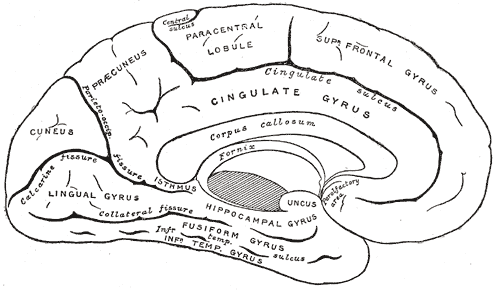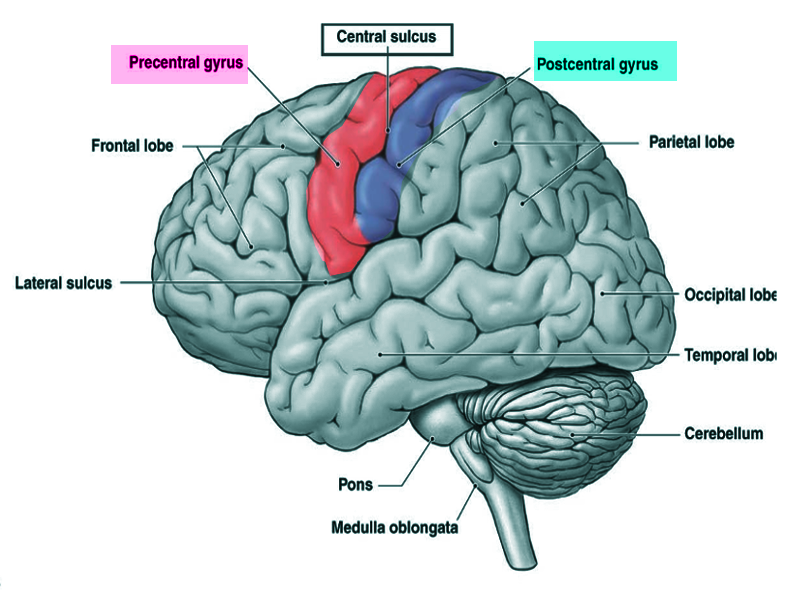[1]
Kropf E, Syan SK, Minuzzi L, Frey BN. From anatomy to function: the role of the somatosensory cortex in emotional regulation. Revista brasileira de psiquiatria (Sao Paulo, Brazil : 1999). 2019 May-Jun:41(3):261-269. doi: 10.1590/1516-4446-2018-0183. Epub 2018 Dec 6
[PubMed PMID: 30540029]
[2]
Lloyd DM, McGlone FP, Yosipovitch G. Somatosensory pleasure circuit: from skin to brain and back. Experimental dermatology. 2015 May:24(5):321-4. doi: 10.1111/exd.12639. Epub 2015 Mar 9
[PubMed PMID: 25607755]
[3]
Lai HC, Seal RP, Johnson JE. Making sense out of spinal cord somatosensory development. Development (Cambridge, England). 2016 Oct 1:143(19):3434-3448
[PubMed PMID: 27702783]
[4]
Akselrod M, Martuzzi R, Serino A, van der Zwaag W, Gassert R, Blanke O. Anatomical and functional properties of the foot and leg representation in areas 3b, 1 and 2 of primary somatosensory cortex in humans: A 7T fMRI study. NeuroImage. 2017 Oct 1:159():473-487. doi: 10.1016/j.neuroimage.2017.06.021. Epub 2017 Jun 17
[PubMed PMID: 28629975]
[5]
Schott GD. Penfield's homunculus: a note on cerebral cartography. Journal of neurology, neurosurgery, and psychiatry. 1993 Apr:56(4):329-33
[PubMed PMID: 8482950]
[6]
Roux FE, Djidjeli I, Durand JB. Functional architecture of the somatosensory homunculus detected by electrostimulation. The Journal of physiology. 2018 Mar 1:596(5):941-956. doi: 10.1113/JP275243. Epub 2018 Jan 19
[PubMed PMID: 29285773]
[7]
Chen TL, Babiloni C, Ferretti A, Perrucci MG, Romani GL, Rossini PM, Tartaro A, Del Gratta C. Human secondary somatosensory cortex is involved in the processing of somatosensory rare stimuli: an fMRI study. NeuroImage. 2008 May 1:40(4):1765-71. doi: 10.1016/j.neuroimage.2008.01.020. Epub 2008 Jan 29
[PubMed PMID: 18329293]
[8]
Darnell D, Gilbert SF. Neuroembryology. Wiley interdisciplinary reviews. Developmental biology. 2017 Jan:6(1):. doi: 10.1002/wdev.215. Epub 2016 Dec 1
[PubMed PMID: 27906497]
[9]
Agirman G, Broix L, Nguyen L. Cerebral cortex development: an outside-in perspective. FEBS letters. 2017 Dec:591(24):3978-3992. doi: 10.1002/1873-3468.12924. Epub 2017 Dec 14
[PubMed PMID: 29194577]
Level 3 (low-level) evidence
[10]
Ribas GC. The cerebral sulci and gyri. Neurosurgical focus. 2010 Feb:28(2):E2. doi: 10.3171/2009.11.FOCUS09245. Epub
[PubMed PMID: 20121437]
[11]
Dall'Orso S, Steinweg J, Allievi AG, Edwards AD, Burdet E, Arichi T. Somatotopic Mapping of the Developing Sensorimotor Cortex in the Preterm Human Brain. Cerebral cortex (New York, N.Y. : 1991). 2018 Jul 1:28(7):2507-2515. doi: 10.1093/cercor/bhy050. Epub
[PubMed PMID: 29901788]
[12]
Frigeri T, Paglioli E, de Oliveira E, Rhoton AL Jr. Microsurgical anatomy of the central lobe. Journal of neurosurgery. 2015 Mar:122(3):483-98. doi: 10.3171/2014.11.JNS14315. Epub 2015 Jan 2
[PubMed PMID: 25555079]
[13]
Zimmerman A, Bai L, Ginty DD. The gentle touch receptors of mammalian skin. Science (New York, N.Y.). 2014 Nov 21:346(6212):950-4. doi: 10.1126/science.1254229. Epub
[PubMed PMID: 25414303]
[14]
MacDonald DB, Dong C, Quatrale R, Sala F, Skinner S, Soto F, Szelényi A. Recommendations of the International Society of Intraoperative Neurophysiology for intraoperative somatosensory evoked potentials. Clinical neurophysiology : official journal of the International Federation of Clinical Neurophysiology. 2019 Jan:130(1):161-179. doi: 10.1016/j.clinph.2018.10.008. Epub 2018 Nov 14
[PubMed PMID: 30470625]
[15]
Hagiwara Y, Goto J, Goto N, Ezure H, Moriyama H. Age-related changes in nerve fibers of the human fasciculus gracilis. Okajimas folia anatomica Japonica. 2003 May:80(1):1-5
[PubMed PMID: 12858959]
[17]
Behrens TE, Johansen-Berg H, Woolrich MW, Smith SM, Wheeler-Kingshott CA, Boulby PA, Barker GJ, Sillery EL, Sheehan K, Ciccarelli O, Thompson AJ, Brady JM, Matthews PM. Non-invasive mapping of connections between human thalamus and cortex using diffusion imaging. Nature neuroscience. 2003 Jul:6(7):750-7
[PubMed PMID: 12808459]
[18]
Basbaum AI, Bautista DM, Scherrer G, Julius D. Cellular and molecular mechanisms of pain. Cell. 2009 Oct 16:139(2):267-84. doi: 10.1016/j.cell.2009.09.028. Epub
[PubMed PMID: 19837031]
[19]
Eckert NR, Vierck CJ, Simon CB, Cruz-Almeida Y, Fillingim RB, Riley JL 3rd. Testing Assumptions in Human Pain Models: Psychophysical Differences Between First and Second Pain. The journal of pain. 2017 Mar:18(3):266-273. doi: 10.1016/j.jpain.2016.10.019. Epub 2016 Nov 22
[PubMed PMID: 27888117]
[20]
White LE, Andrews TJ, Hulette C, Richards A, Groelle M, Paydarfar J, Purves D. Structure of the human sensorimotor system. I: Morphology and cytoarchitecture of the central sulcus. Cerebral cortex (New York, N.Y. : 1991). 1997 Jan-Feb:7(1):18-30
[PubMed PMID: 9023429]
[21]
Yoshimura S, Sato W, Kochiyama T, Uono S, Sawada R, Kubota Y, Toichi M. Gray matter volumes of early sensory regions are associated with individual differences in sensory processing. Human brain mapping. 2017 Dec:38(12):6206-6217. doi: 10.1002/hbm.23822. Epub 2017 Sep 20
[PubMed PMID: 28940867]
[22]
Taylor L, Jones L. Effects of lesions invading the postcentral gyrus on somatosensory thresholds on the face. Neuropsychologia. 1997 Jul:35(7):953-61
[PubMed PMID: 9226657]
[23]
Deng WS, Zhou XY, Li ZJ, Xie HW, Fan MC, Sun P. Microsurgical treatment for central gyrus region meningioma with epilepsy as primary symptom. The Journal of craniofacial surgery. 2014 Sep:25(5):1773-5. doi: 10.1097/SCS.0000000000000889. Epub
[PubMed PMID: 24999673]
[24]
Rey-Dios R, Cohen-Gadol AA. Technical nuances for surgery of insular gliomas: lessons learned. Neurosurgical focus. 2013 Feb:34(2):E6. doi: 10.3171/2012.12.FOCUS12342. Epub
[PubMed PMID: 23373451]
[25]
De Witt Hamer PC, Robles SG, Zwinderman AH, Duffau H, Berger MS. Impact of intraoperative stimulation brain mapping on glioma surgery outcome: a meta-analysis. Journal of clinical oncology : official journal of the American Society of Clinical Oncology. 2012 Jul 10:30(20):2559-65. doi: 10.1200/JCO.2011.38.4818. Epub 2012 Apr 23
[PubMed PMID: 22529254]
Level 1 (high-level) evidence
[26]
Frey D, Schilt S, Strack V, Zdunczyk A, Rösler J, Niraula B, Vajkoczy P, Picht T. Navigated transcranial magnetic stimulation improves the treatment outcome in patients with brain tumors in motor eloquent locations. Neuro-oncology. 2014 Oct:16(10):1365-72. doi: 10.1093/neuonc/nou110. Epub 2014 Jun 12
[PubMed PMID: 24923875]
[27]
Magill ST, Han SJ, Li J, Berger MS. Resection of primary motor cortex tumors: feasibility and surgical outcomes. Journal of neurosurgery. 2018 Oct:129(4):961-972. doi: 10.3171/2017.5.JNS163045. Epub 2017 Dec 8
[PubMed PMID: 29219753]
Level 2 (mid-level) evidence
[28]
Tegenthoff M, Ragert P, Pleger B, Schwenkreis P, Förster AF, Nicolas V, Dinse HR. Improvement of tactile discrimination performance and enlargement of cortical somatosensory maps after 5 Hz rTMS. PLoS biology. 2005 Nov:3(11):e362
[PubMed PMID: 16218766]
[29]
Pleger B, Blankenburg F, Bestmann S, Ruff CC, Wiech K, Stephan KE, Friston KJ, Dolan RJ. Repetitive transcranial magnetic stimulation-induced changes in sensorimotor coupling parallel improvements of somatosensation in humans. The Journal of neuroscience : the official journal of the Society for Neuroscience. 2006 Feb 15:26(7):1945-52
[PubMed PMID: 16481426]
[30]
Almeida L, Deeb W, Spears C, Opri E, Molina R, Martinez-Ramirez D, Gunduz A, Hess CW, Okun MS. Current Practice and the Future of Deep Brain Stimulation Therapy in Parkinson's Disease. Seminars in neurology. 2017 Apr:37(2):205-214. doi: 10.1055/s-0037-1601893. Epub 2017 May 16
[PubMed PMID: 28511261]
[31]
Bradberry TJ, Metman LV, Contreras-Vidal JL, van den Munckhof P, Hosey LA, Thompson JL, Schulz GM, Lenz F, Pahwa R, Lyons KE, Braun AR. Common and unique responses to dopamine agonist therapy and deep brain stimulation in Parkinson's disease: an H(2)(15)O PET study. Brain stimulation. 2012 Oct:5(4):605-15. doi: 10.1016/j.brs.2011.09.002. Epub 2011 Oct 5
[PubMed PMID: 22019080]
[32]
Sridharan KS, Højlund A, Johnsen EL, Sunde NA, Johansen LG, Beniczky S, Østergaard K. Differentiated effects of deep brain stimulation and medication on somatosensory processing in Parkinson's disease. Clinical neurophysiology : official journal of the International Federation of Clinical Neurophysiology. 2017 Jul:128(7):1327-1336. doi: 10.1016/j.clinph.2017.04.014. Epub 2017 May 2
[PubMed PMID: 28570866]
[33]
Apkarian AV, Bushnell MC, Treede RD, Zubieta JK. Human brain mechanisms of pain perception and regulation in health and disease. European journal of pain (London, England). 2005 Aug:9(4):463-84
[PubMed PMID: 15979027]
[34]
Zhuo M. Descending facilitation. Molecular pain. 2017 Jan:13():1744806917699212. doi: 10.1177/1744806917699212. Epub
[PubMed PMID: 28326945]
[35]
Corder G, Castro DC, Bruchas MR, Scherrer G. Endogenous and Exogenous Opioids in Pain. Annual review of neuroscience. 2018 Jul 8:41():453-473. doi: 10.1146/annurev-neuro-080317-061522. Epub 2018 May 31
[PubMed PMID: 29852083]
[36]
Naser PV, Kuner R. Molecular, Cellular and Circuit Basis of Cholinergic Modulation of Pain. Neuroscience. 2018 Sep 1:387():135-148. doi: 10.1016/j.neuroscience.2017.08.049. Epub 2017 Sep 8
[PubMed PMID: 28890048]


